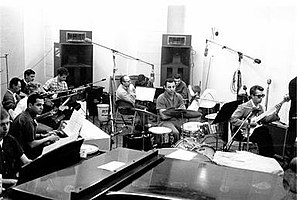
Back The Wrecking Crew (Studiomusiker) German The Wrecking Crew (música) Spanish گروه درهمنوازی Persian The Wrecking Crew Finnish The Wrecking Crew French The Wrecking Crew (gruppo musicale) Italian レッキング・クルー (音楽) Japanese The Wrecking Crew (studiomuzikanten) Dutch The Wrecking Crew NB
The Wrecking Crew | |
|---|---|
 Members of the Wrecking Crew employed for a session at Gold Star Studios in the 1960s. Seated left to right: Don Randi, Al De Lory, Carol Kaye, Bill Pitman, Tommy Tedesco, Irving Rubins, Roy Caton, Jay Migliori, Hal Blaine, Steve Douglas, and Ray Pohlman. | |
| Background information | |
| Also known as |
|
| Origin | Los Angeles, California, U.S. |
| Genres | |
| Years active | 1960s–1970s |
| Past members |
|
The Wrecking Crew is a loose collective of American session musicians based in Los Angeles whose services were employed for a great number of studio recordings in the 1960s and 1970s, including hundreds of top 40 hits. The musicians were not publicly recognized in their era, but were viewed with reverence by industry insiders. They are now considered one of the most successful and prolific session recording units in music history.
Most of the players associated with The Wrecking Crew had formal backgrounds in jazz or classical music. The group had no official name in its early years, and it remains a subject of contention when they exactly were first referred to as "The Wrecking Crew". Drummer Hal Blaine may have first used this name as early as the late 1960s. The name was in common use by April 1981 when Hal Blaine used it in an interview with Modern Drummer magazine. The name became even more widely known when Blaine used it in his 1990 memoir, attributing it to older musicians who felt that the group's embrace of rock and roll was going to "wreck" the music industry. Some of Blaine's colleagues corroborated his account, while guitarist/bassist Carol Kaye contended that they were called "the Clique". Another unofficial name was "the First Call Gang",[1] sometimes used in the 1950s for an early version of the group headed by bassist Ray Pohlman that featured some of the same musicians.
The unit coalesced in the early 1960s as the de facto house band for Phil Spector and helped realize his Wall of Sound production style. They subsequently became the most requested session musicians in Los Angeles, playing behind many popular recording artists including Jan and Dean, Sonny & Cher, the Mamas and the Papas, the 5th Dimension, Frank Sinatra, and Nancy Sinatra. The musicians were sometimes used as "ghost players" on recordings credited to rock groups, such as the Byrds' debut rendition of Bob Dylan's "Mr. Tambourine Man" (1965), the first two albums by the Monkees, and the Beach Boys' 1966 album Pet Sounds.
The Wrecking Crew's contributions to so many hit recordings went largely unnoticed until the publication of Blaine's memoir and the attention that followed. Keyboardist Leon Russell and guitarist Glen Campbell were members who became popular solo acts, while Blaine is reputed to have played on more than 140 top-ten hits, including approximately 40 number-one hits. Other musicians who formed the unit's ranks were drummer Earl Palmer, saxophonist Steve Douglas, guitarist Tommy Tedesco, and keyboardist Larry Knechtel, who became a member of Bread. Blaine and Palmer were among the inaugural "sidemen" inductees to the Rock and Roll Hall of Fame in 2000, and The Wrecking Crew was entirely inducted into the Musicians Hall of Fame and Museum in 2007. In 2008, they were the subject of the documentary The Wrecking Crew.
- ^ "The Wrecking Crew: The story of rock's greatest studio band". faroutmagazine.co.uk. October 18, 2021.
© MMXXIII Rich X Search. We shall prevail. All rights reserved. Rich X Search